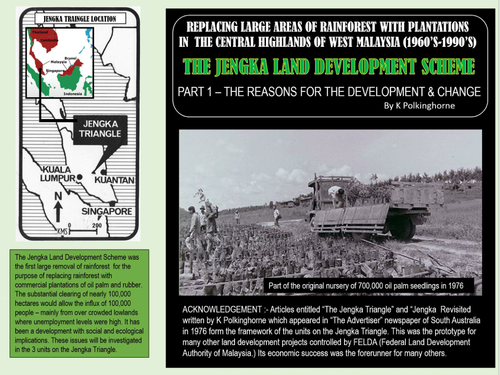

The removal of natural rainforests continues at a significant rate. In a world where human population growth threatens the capacity of food production to keep up with demand the frontiers of development have been pierced. This situation occurred in Malaysia in the 1960's. Under employed and unemployed farmers on the highly populated lowlands of West Malaysia (the Malayan Peninsula) were a significant problem for the Malaysian Economy. One solution was to look towards the rainforest interiors and consider the potential for the land beneath the rainforests to be converted into plantation areas. This would alleviate the employment situation and provide export potential for thew Malaysian Economy. The conversion from forest to plantation required the removal of rainforest. The first large scale programme was the development of "The Jengka Triangle" Project. This first unit considers the thinking and planning of this scheme. It indicates the where and why of the project and explains why the project was supported, planned and guided by FELDA - a Malaysian Government department. Join in the story from the ground floor planning stage and then see what happens as the Jengka Triangle is develops and is completed. A check question sheet is given as an attachment. This unit can stand alone but if you want the whole story then cover parts 2 and 3 in the series. The economic success in the Jengka Triangle encouraged further large scale projects in West Malaysia and in Sabah (See part 4 in the Rainforest series on Sabah which concentrates on changes and impacts caused by the expansion of oil palm plantations on cleared rainforest land.
Something went wrong, please try again later.
This resource hasn't been reviewed yet
To ensure quality for our reviews, only customers who have downloaded this resource can review it
Report this resourceto let us know if it violates our terms and conditions.
Our customer service team will review your report and will be in touch.
£0.00
